Hot dip galvanizing is a remarkable corrosion protection method. It is common for galvanized steel to last more than 70 years under the right conditions. This service life practically doubles the one provided by most high-performance protective coating systems such as zinc-rich primer, epoxy, and polyurethane when exposed to low ISO 12944-2 C2 low corrosivity environments.
The hot dip galvanizing process requires numerous steps and most importantly the capacity of the items to fit in several baths and drain the liquids they are immersed in. Hot dip galvanized items are subject to degreasing, rinsing, pickling, rinsing, pre-fluxing, drying, zinc immersion, cooling, and inspection. Once the process is completed, the metallurgical bond between the zinc and the steel substrate forms four distinct layers growing outward from the steel surface. The layers consist of various alloyed combinations of zinc and iron and provide three levels of corrosion resistance to steel: barrier protection, cathodic protection, and zinc patina.
We have discussed the advantages of hot dip galvanizing. What are the disadvantages then? First, it is important to know that not all steels are galvanizing-friendly. The general guidance for steel selection recommends levels of carbon less than 0.25 percent; phosphorus less than 0.04 percent, manganese less than 1.35 percent, and silicon levels between 0.15 and 0.22 percent (ideally less than 0.04 percent). When the silicon content exceeds 0.22 percent, the steel is classified as reactive. Reactive steels typically present an excessively thick zinc layer which translates into brittle galvanizing and a lower cohesive strength than would typically be expected. Depending on other factors, such as the exposure environment, these diminished properties can lead to the cohesive separation of the zinc layer. Also, excessive carbon content (i.e., steel castings) could trigger liquid metal-assisted cracking (LMAC). Another factor to consider before selecting hot dip galvanizing as the preferred corrosion protection method is its service temperature. Temperature applications of hot-dip galvanized steel above 480 F (250 C) are not recommended. Also, exposure to soils containing high moisture, high chlorides, or low PH would considerably decrease hot dip galvanizing service life.

